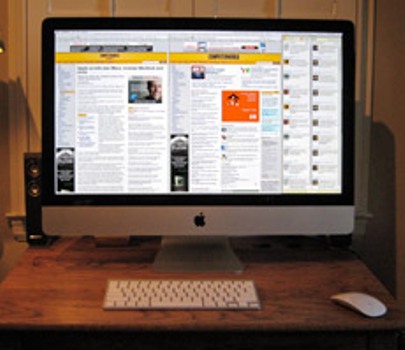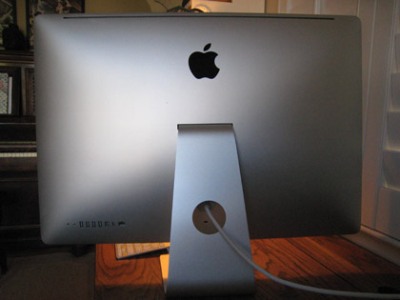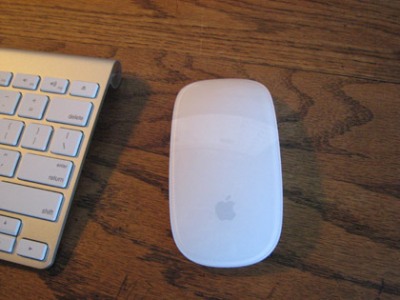Apple’s new 27-in. iMac can be described in one word: stunning.
Don’t take my word for it. That’s based on the cluster of techie-types and graphic designers who popped into my office last week to get a gander at the newest all-in-one Mac from Apple. Part of it might have been the novelty: Apple unveiled these larger, widescreen iMacs on Oct. 20 and sent one over for review purposes two days later. It’s the biggest change for the iMac since it went aluminum-and-black in late 2007.
Yes, it comes with more processing power and the sleek new Magic Mouse, which several people tried out to mixed reviews. (I love it; others found it a little heavy.) But mostly, it was the super-high-resolution screen that drew people in.

*The new 27-in. iMac offers enough screen resolution to display two Web pages with room left over.
That screen, the largest LED-backlit computer display out there for now, offers a resolution of 2,560 by 1,440 pixels for a true 16×9 aspect ratio. That’s 90 per cent of the screen real estate you’d get from Apple’s gargantuan 30-in. Cinema Display and it’s perfect for viewing high-definition (HD) content. Judging from the coos of approval I heard when I fired up some HD movie trailers for the huddled masses, this iMac should sell well.
In fact, HD content is so sharp and bright that it almost looks 3-D. The big question you’ll be asking yourself is: “Do I put this in an office or show it off in the living room?” (I’m having that exact discussion right now with my partner.)
A revamped iMac line
Overall, Apple revamped its entire line of iMacs at the same time it updated the MacBook and Mac Mini. The basic iMac starts at the same price as before — $1,199 — but it has undergone a growth spurt. Instead of a 20-in. screen, the new iMac gains an inch and a half in diagonal width, bringing it to 21.5 inches and a 1920-by-1080-pixel resolution. That’s essentially the same resolution as the old 24-in. model, and with those pixels packed tighter in the 21.5-in. form factor, they look better than ever.
Apple likely to ‘muddle through’ gloomier sales outlook
According to Apple, the basic model — and its slightly pricier $1,499 brother — offers 17 per cent more pixels than the old 20-in. iterations. The main difference between the two is the size of the hard drive and the graphics cards. The $1,499 iMac comes with a 1TB drive, offering twice the capacity of the basic model, and uses the ATI Radeon HD 4670 video card with 256MB of video RAM.
The $1,199 model gets by with the now-ubiquitous Nvidia GeForce 9400M card, which relies on 256MB of shared system memory and is used in a number of Apple products.
The model I reviewed, which sells for $1,699 and offers the larger screen, is not even the high-end iMac. That title goes to the $1,999 version, which won’t be shipping until next month and comes with an Intel Core i5 quadcore processor.
All of the iMacs (except the top model) come with a 3.06-GHz Core 2 Duo chip and 4GB of RAM. But Apple has added two more RAM slots, making it easy (though not necessarily cheaper) to max out the memory.
For most users, 4GB should be plenty. But if you do decide to add more RAM, you can double it to 8GB or even quadruple it to 16GB. Doing so will cost you, though: $200 if you want to go to 8GB and $1,400 if you go to 16GB. (You can usually get RAM cheaper by buying it from a third-party supplier and installing it yourself.)
Though 4GB is enough for most users, if you’re running a virtualized operating system or two, you’ll find that 8GB gives you room for Mac OS X Snow Leopard and whatever flavor of Windows or Linux you want to run at the same time. You can also boost the processor from 3.06 GHz to 3.33 GHz for $200, though it’s unlikely to make enough difference to warrant the expense. If you’re looking for the best use for your $200, get extra RAM.
Going quad?
If you really want to move, you can treat yourself to one of the quadcore processors Apple will soon be offering, the first time it’s done so in an iMac. (Until now, quadcores have been limited to the Mac Pro line.)
The basic chip (can a quadcore in an iMac really ever be basic?) is a 2.66-Ghz processor from Intel’s Lynnfield line. Those processors were just released in September, which is why the high-end iMacs aren’t available yet.
Apple should finally start shipping them in November. When in November? Apple isn’t saying. You may be able to get your hands on one next week. Or you may still be eating Thanksgiving leftovers when the quadcore models finally ship — assuming there aren’t any delays. Either way, if performance is your measuring stick, the delay should be worth the wait.
If the Core i5 isn’t enough power for you, there’s an optional 2.8-Ghz Core i7. It’ll set you back an additional $200, which puts the price tag for the meanest, fastest iMac available at $2,199. That, combined with the super-size screen, should offer a powerful punch for anyone who needs the horsepower — or just wants the fastest thing on the block. (Count me in that latter group.)
According to Apple, both of the Core chips can run at faster frequencies if all of their cores aren’t being taxed at 100 per cent. With Intel’s Turbo Boost technology, the 2.66-GHz chip can go up to 3.2 GHz and the faster 2.8-GHz processor can zip up to 3.46 GHz. In addition, it supports Hyper-Threading, allowing the Mac OS X 10.6 Snow Leopard to take advantage of all four cores. Both of the Core processors also have 8MB of Level 3 cache memory and an integrated memory controller, which helps them churn through data even faster.
Apple says the Core i5 processor is about twice as fast as the 3.06-GHz processor in the old top-end iMac, and the Core i5 is 2.4 times faster.
More high-end tweaks
In addition to opting for a faster processor and more RAM, you can also max out the hard drive with a 2TB model for an extra $250. That’s going to be useful if you decide to use your iMac for downloading and watching a lot of digital video. Given the limited upgrade options for the iMac, it pays to assess your needs wisely and choose accordingly when you buy. No doubt, 2TB sounds like a lot of growing room now, but will it feel that way in three years?
On the 27-in. model I’m using, you can move from the ATI Radeon HD 4670 graphics card with 256MB of video RAM to an ATI Radeon HD 4850, which doubles the video RAM and offers an 80 per cent performance boost for $150 more. Videographers and gamers take note.
The hardware behind the screen combines to offer a level of performance that should be beyond plenty for most users. I fired up the Xbench benchmarking app for a quick performance test and got a sizzling score of 187 — 11 points higher than the same chip clocks in at on my 17-in. MacBook Pro. It’s so fast that I don’t even miss the solid-state disk (SSD) drive I have in my MacBook Pro. (All things being equal, an SSD drive can make a computer feel a lot faster than it really is in day-to-day use.) No doubt, the quadcore chips will do even better.

*The back of the new iMac is all aluminum. Ports are located to the lower left.
The body of the iMac is now made entirely of aluminum. The flat black plastic used on the back in earlier models is gone, allowing Apple to use its unibody design process to carve the chassis out of a solid block of aluminum. The front “chin” below the screen (it’s not as big as before) is added on later, but you’d never know it to look at it.
What you will notice, especially if you’re familiar with the old 24-in. iMac, is that this one is five pounds heavier, weighing in at 30.5 lbs. (The 21.5-in. model weighs just over 20 lbs.) Another change: The screen glass now runs from edge to edge and is surrounded by a black bezel. It gives the iMac a more refined look.
Mighty mouse and multimedia
The screen, which manages to crowd in 109 pixels per inch, is the biggest selling point. But it’s not the only change Apple rolled out with this update. It also unveiled its new wireless Magic Mouse. Along with a tweaked wireless keyboard that now uses two AA batteries (rather than three), the Magic Mouse is now part of the iMac bundle.
The mouse has no buttons and is made of aluminum on the bottom and white polycarbonate plastic with a smooth finish on top. You can scroll through Web pages, documents and photos vertically, or use two-finger gestures to swipe left and right. I love the scrolling and right-left “button” motions. I’m less enamored of the two-finger swipes, because you have to hold the mouse in place with your thumb and ring fingers while swiping with your index and middle fingers. I tried it, it works, but I’m fine without it.
The mouse is darn stylish, though. There’s something about the seamless curves and the materials that remind me of a Ferrari. (If you’re interested in just the mouse, one will set you back $69. What price style?)

*As stylish as the new iMac is, Apple’s new Magic Mouse looks even better.
Apple also added a Mini DisplayPort that can be used to hook up another display — though I can’t imagine why you’d need to — or, more important, use the iMac as a display itself.
And that’s where the office-vs.-living-room debate arises. The screen size allows you to have numerous windows open at one time — perfect for word processing, digital photo work or any kind of graphics endeavors. It also allows you to watch HD video in amazing clarity and with vibrant color saturation. Given the top-notch industrial design for which Apple is known, this iMac would look as appropriate in the living room as it does on a desk.
The wireless keyboard and mouse make it easy to set up the iMac as a media centre, since you can pretty much fire up iTunes and watch DVDs from a distance without having to worry about cords. And if you have a digital camera that uses SD cards, you can now slip them right into the built-in SD card slot on the right side of the iMac (next to the CD/DVD slot). With Apple’s iPhoto application, you’ve got an instant slide show.
The only thing missing from this would-be multimedia showpiece is a Blu-Ray player. For whatever reason, Apple has been reluctant to add Blu-Ray drives to any of its hardware, and this iMac really cries out for it. Regular DVDs look a little soft and can show digital artifacts, but if the HD movie trailers I viewed are any measure, Blu-Ray would be flat-out awesome. Of course, then you might be less inclined to buy or rent HD movies through iTunes.
(According to Apple, it’s possible to connect up an external Blu-Ray player — but an adapter will be needed to convert the HDMI signal coming from the player to the MiniDisplay Port on the iMac. And a scaler would be needed because of the screen’s high resolution. Apple doesn’t sell those, though, so it’ll be up to another company to come up with a solution.)
I do wonder what this iMac’s introduction means for Apple’s beautiful, but now aging, 30-in. Cinema Display monitor. Sure, it has a slightly higher resolution because of its 16×10 aspect ratio. But it costs $100 more than the 27-in. iMac and it’s just a display. With the iMac, you get 90 per cent of the Cinema Display’s screen real estate, and a high-powered computer built in. You’d have to really need that 30-in. screen to justify the expense. I wouldn’t be surprised to see Apple update the Cinema Display soon, either by bumping up its resolution or by downsizing it to 27 inches and cutting the price. That’s just speculation; Apple doesn’t talk about future product plans.
Speaking of cost, it’s important to note that the 27-in. model is $100 less than the $1,799 24-in. iMac that preceded it. And the $1,999 quadcore model to come costs $200 less than the old top-end iMac. Apple has been dinged for too often holding the line on prices, so the price drops are noteworthy in these recessionary times.
Conclusions
Apple’s flagship iMac comes in a variety of flavors and two sizes, with the $1,699 model I’ve been using being the sweet spot. It offers the most value for the price and could spur desktop sales. In recent years, more and more Mac buyers — including me — have opted for Apple’s popular line of laptops.
Desktops, in some ways, have fallen out of favor, given the prevalence of wireless connections and the public’s desire for mobility.
But with an absolutely stunning screen, a lot of under-the-hood performance improvements, the wireless keyboard and the new mouse, and flexibility that makes it fit in at work or at home, this new iMac could lead to a resurgence in desktop sales for Apple.
With the holidays soon upon us, I know of at least one laptop owner who’s waiting to check out those quadcore models when they arrive next month. Me.
Source: Computerworld




